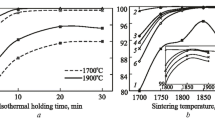Abstract
Several electrorheological (ER) materials systems composed of amorphous ceramic powders dispersed in light paraffin oil were developed to determine if relationships among ER activities, dielectric properties, compositions, porosities, and oxide species could be identified. The results of the studies suggested that trends among ER activity, dielectric phenomena, and alkali metal species existed. The aluminosilicate powders developed with various alkali metals showed that the ER activity increased as the activation energy decreased. The sodium aluminosilicate appeared to have the greatest ER activity and the lowest activation energy, while the cesium aluminosilicate displayed the weakest ER response, but had the highest activation energy. The thermodielectric responses of the different oxide materials systems developed with sodium showed that the mechanisms contributing to the dielectric dispersions had similar activation energies; however, the magnitudes of the recorded ER activities varied, and thus a direct correlation was not apparent. In addition, studies conducted with ER materials composed of sodium aluminosilicate powders of varying porosities showed that ER activities increased with increasing porosity. Furthermore, the analysis of the results of the thermodielectric and rheological studies of the different amorphous materials ER systems suggested that these materials may have an optimal stimulus frequency/temperature for ER activity.
Similar content being viewed by others
References
D. L. Hartsock, R. F. Novak, and G. J. Chaundry, J. Rheol. 35 (7), 1305 (1991).
N. K. Petek, R. J. Goudie, and F. P. Boyle, SAE Paper #881785 (1992).
T. Ushijima, K. Takano, and T. Noguchi, SAE Paper #881787 (1992).
F. E. Filisko and L. H. Radzilowski, J. Rheol. 34 (4), 539–552 (1990).
F. E. Filisko, in Proceedings from the Third International Conference on Electrorheological Materials, Carbondale, IL (1991).
D. R. Gamota and F. E. Filisko, J. Rheol. 34 (4), 539 (1990).
P. Kansal and R. M. Laine, J. Am. Ceram. Soc. 77, 875 (1994).
D. R. Gamota, B. L. Mueller, and F. E. Filisko, patent submission (1994).
R. A. Anderson, in Proceedings from the Third International Conference on Electrorheological Materials, Carbondale, IL (1991).
J. M. Davis, J. Appl. Phys. 72, 1334 (1992).
J. M. Ginder and S. L. Ceccio, J. Rheol. 39 (1), 211 (1995).
A. P. Gast and C. F. Zukoski, Adv. Colloid Interface Sci. 30, 153 (1989).
E. Matijević, Langmuir 2, 12 (1986).
L. C. Klein, in Sol-gel technology for Thin Films, Fibers, Preforms, Electronics, and Specialty Shapes, edited by L. C. Klein (1986), pp. 382–399.
D. W. Breck, Zeolite Molecular Sieves (Robert E. Kreiger Publishing Company, Malabar, FL, 1984), pp. 392–410.
D. L. Klass and T. W. Martinek, J. Appl. Phys. 38, 67 (1967).
Z. P. Shulman, V. I. Kordonsky, E. A. Zoltsgendler, I. V. Prohorov, B. M. Khusid, and S. A. Demchuk, Int. J. Multiphase Flow 12, 935 (1986).
O. L. Anderson and D. A. Stuart, J. Am. Ceram. Soc. 37 (12), 573 (1954).
H. K. Patel and S. W. Martin, Solid State Ionics 53, 1148 (1992).
Author information
Authors and Affiliations
Rights and permissions
About this article
Cite this article
Gamota, D.R., Schubring, A.W., Mueller, B.L. et al. Amorphous ceramics as the particulate phase in electrorheological materials systems. Journal of Materials Research 11, 144–155 (1996). https://doi.org/10.1557/JMR.1996.0018
Received:
Accepted:
Published:
Issue Date:
DOI: https://doi.org/10.1557/JMR.1996.0018




